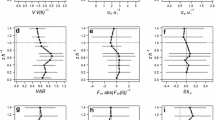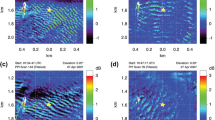Abstract
Observations of low-level jets (LLJs) at the Howland AmeriFlux site in the USA and the jet’s impact on nocturnal turbulent exchange and scalar fluxes over a tall forest canopy are discussed. Low-frequency motions and turbulent bursts characterize moderately strong LLJs, whereas low-frequency motions are suppressed during periods with strong LLJs and enhanced shear. An analysis based on the shear-sheltering hypothesis seeks to elucidate the effect of LLJs on flux measurements. In the absence of shear sheltering, large eddies penetrate the roughness sublayer causing enhanced mixing while during periods with shear sheltering, mixing is reduced. In the absence of the latter, ‘upside-down’ eddies are primarily responsible for the enhanced velocity variances, scalar and momentum fluxes. The integral length scales over the canopy are greater than the canopy height. The variance spectra and cospectra from the wavelet analysis indicate that large eddies (spatial scale greater than the low-level jet height) interact with active canopy-scale turbulence, contributing to counter-gradient scalar fluxes.
Similar content being viewed by others
References
Baldocchi DD and Meyers TP (1988). Turbulence structure in a deciduous forest. Boundary-Layer Meteorol 43: 345–364
Banta RM, Newsom RK, Lundquist JK, Pichugina YL, Coulter RL and Mahrt L (2002). Nocturnal low-level jet characteristics over kansas during cases-99. Boundary-Layer Meteorol 105: 221–252
Banta RM, Pichugina YL and Newsom RK (2003). Relationship between low-level jet properties and turbulence kinetic energy in the nocturnal stable boundary layer. J Atmos Sci 60: 2549–2555
Banta RM, Pichugina YL and Alan BW (2006). Turbulent velocity-variance profiles in the stable boundary layer generated by a nocturnal low-level jet. J Atmos Sci 63: 2700–2719
Beyrich F (1994). Sodar observations of the stable boundary-layer height in relation to the nocturnal low-level jet. Meteorol Zeitschrift 3: 29–34
Blackadar AK (1957). Boundary layer wind maxima and their significance for the growth of nocturnal inversions. Bull Amer Meteorol Soc 38: 283–290
Bonner WD (1968). Climatology of the low-level jet. Mon Wea Rev 96: 833–850
Brunet Y and Irvine MR (2000). The control of coherent eddies in vegetation canopies: streamwise structure spacing, canopy shear scale and atmospheric stability. Boundary-Layer Meteorol 94: 139–163
Businger JA (1973) Workshop on the planetary boundary layer. In: Haugen DA (ed) Amer Meteorol Soc 67–98
Cava D, Schipa S and Giostra U (2005). Investigation of low-frequency perturbations induced by a steep obstacle. Boundary-Layer Meteorol 115: 27–45
Collineau S and Brunet Y (1993). Detection of turbulent coherent motions in a forest canopy, Part I: wavelet analysis. Boundary-Layer Meteorol 65: 357–379
Collineau S and Brunet Y (1993). Detection of turbulent coherent motions in a forest canopy, Part II: timescales and conditional averages. Boundary-Layer Meteorol 66: 49–73
Corsmeier U, Kalthoff N, Kolle O, Kotzian M and Fiedler F (1997). Ozone concentration jump in the stable nocturnal boundary-layer during a LLJ-event. Atmos Environ 31: 1977–1989
Cuxart J, Morales G, Terradellas E and Yague C (2002). Study of coherent structures and estimation of the pressure transport terms for the nocturnal stable boundary layer. Boundary-Layer Meteorol 105: 305–328
Daubechies I (1993). Ten Lectures on Wavelets. CBMS-NSF regional conference series in Applied Mathematics SIAM 61: 357
Falge E, Baldocchi D, Olson R, Anthoni P, Aubinet M, Bernhofer C, Burba G, Ceulemans R, Clement R, Dolman H, Granier A, Gross P, Grünwald T, Hollinger D, Jensen N, Katul G, Keronen P, Kowalski A, Lai CT, Law BE, Meyers T, Moncrieff J, Moors E, Munger JW, Pilegaard K, Rannik Ü, Rebmann C, Suyker A, Tenhunen J, Tu K, Verma S, Vesala T, Wilson K and Wofsy S (2001). Gap filling strategies for defensible annual sums of net ecosystem exchange. Agric For Meteorol 107: 43–69
Farge M (1992). Wavelet transforms and their applications to turbulence. Ann Rev Fluid Mech 24: 395–457
Finnigan JJ (1979). Turbulence in waving wheat. I Mean statistics and Honami. Boundary-Layer Meteorol 16: 181–211
Finnigan JJ (2000). Turbulence in plant canopies. Ann Rev Fluid Mech 32: 519–571
Gao W and Li BL (1993). Wavelet analysis of coherent structures at the atmosphere–forest Interface. J Appl Meteorol 32: 1717–1725
Giostra U, Cava D and Schipa S (2002). Structure functions in a wall-turbulent shear flow. Boundary-Layer Meteorol 103: 337–359
Grossman A and Morlet J (1984). Decomposition of Hardy functions into square integrable wavelets of constant shape. SIAM J Math Anal 15: 723–736
Gu LH, Falge EM, Boden T, Baldocchi DD, Black TA, Saleska SR, Suni T, Verma SB, Vesala T, Wofsy SC and Xu LK (2005). Objective threshold determination for nighttime eddy flux filtering. Agric For Meteorol 128: 179–197
Högström U (1990). Analysis of turbulence structure in the surface layer with a modified similarity theory formulation for neutral conditions. J Atmos Sci 47: 1949–1972
Högström U (1996). Review of some basic characteristics of the atmospheric surface layer. Boundary-Layer Meteorol 78: 215–246
Högström U, Hunt JCR and Smedman A (2002). Theory and measurements for turbulence spectra and variances in the atmospheric neutral surface layer. Boundary-Layer Meteorol 103: 101–124
Hollinger DY, Goltz SM, Davidson EA, Lee JT, TuK and Valentine HT (1999). Seasonal Patterns and environmental control of carbon dioxide and water vapour exchange in an ecotonal boreal forest. Global Change Biol 5: 891–902
Hollinger DY, Aber J, Dail B, Davidson EA, Goltz SM, Hughes H, Leclerc MY, Lee JT, Richardson AD, Rodrigues C, Scott NA, Achuatavarier D and Walsh J (2004). Spatial and temporal variability in forest-atmosphere CO2 exchange. Global Change Biol 10: 1689–1706
Hunt JCR and Durbin PA (1999). Perturbed vortical layers and shear-sheltering. Fluid Dyn Res 24: 375–404
Hunt JCR and Morrison JF (2000). Eddy structure in turbulent boundary layers. Euro J.Mech B – Fluids 19: 673–694
Kaimal JC and Finnigan JJ (1994). Atmospheric boundary layer flows: their structure and measurement. Oxford University Press, UK,, 304 pp
Kalthoff N, Horlacher V, Corsmeier U, Voltz-Thomas A, Kolahgar B, Giess H, Mollmann-Coers M and Knaps A (2000). Influence of valley winds on transport and dispersion of airborne pollutants in the Freiburg-Schauinsland Area. J Geophys Res 105: 1585–1597
Karipot A, Leclerc MY, Zhang G, Martin T, Starr G, Hollinger D, Hipps LE, McCaughey LE, Anderson DJ and Hendrey GR (2006). Nocturnal CO2 exchange over a tall forest canopy associated with intermittent low-level jet activity. Theor Appl Climatol 85: 243–248
Katul GG and Parlange MB (1995). The spatial structure of turbulence in the dynamic and dynamic-convective sublayers using wavelet transforms. Boundary-Layer Meteorol 75: 81–108
Lee X and Hu X (2002). Forest-air fluxes of carbon and energy over non-flat terrain. Boundary-Layer Meteorol 103: 277–301
McNaughton KG and Brunet Y (2002). Townsend’s hypothesis coherent structures and Monin-Obukhov similarity. Boundary-Layer Meteorol 102: 161–175
Mahrt L (1999). Stratified atmospheric boundary layers. Boundary-Layer Meteorol 90: 375–396
Mahrt L and Vickers D (2002). Contrasting vertical structures of nocturnal boundary-layers. Boundary-Layer Meteorol 105: 351–363
Meyers SD, Kelley BG and O’Brien JJ (1993). An introduction to waveleta analysis in oceanography and meteorology: with application to the dispersion of Yanai waves. Mon Wea Rev 121: 2858–28661
Mursch-Radlgruber E (1995). Observations of flow structure in a small forested valley system. Theor Appl Climatol 52: 3–17
Nappo CJ (1991). Sporadic breakdown of stability in the PBL over simple and complex terrain. Boundary-Layer Meteorol 54: 69–87
Newsom RK and Banta RM (2002). Shear-flow instability in the stable nocturnal boundary-layer as observed by Doppler lidar during CASES-99. J Atmos Sci 60: 16–33
Piper M and Lundquist JK (2004). Surface layer turbulence measurements during a frontal passage. J Atmos Sci 61(14): 1768–1780
Poulos GS, Bossert JE, McKee TB and Pielke RA (2000). The interaction of katabatic flow and mountain waves, Part I: observations and idealized simulations. J Atmos Sci 57: 1919–1936
Poulos GS, Bossert JE, McKee TB and Pielke RA (2007). The interaction of katabatic flow and mountain waves. Part II: case study analysis and conceptual model. J Atmos Sci 64: 1857–1879
Prabha TV, Leclerc MY, Karipot A and Hollinger DY (2007). Low-frequency effects on eddy covariance fluxes under the influence of a low-level jet. J Appl Meteor Climatol 46: 338–352
Pulido M and Chimonas G (2001). Forest canopy waves: the long wavelength component. Boundary-layer Meteorol 100: 209–224
Qiu J, Paw UKT and Shaw RH (1995). Pseudo-wavelet analysis of turbulence patterns in three vegetation layers. Boundary-layer Meteorol 72: 177–204
Rannik U and Vesala T (1999). Autoregressive filtering versus linear detrending in estimation of fluxes by the eddy covariance method. Boundary-Layer Meteorol 91: 259–280
Raupach MR (1981). Conditional statistics of reynolds stress in rough-wall and smooth-wall turbulent boundary layers. J Fluid Mech 108: 63–382
Raupach MR, Finnigan JJ and Brunet Y (1996). Coherent eddies and turbulence in vegetation canopies. Boundary-Layer Meteorol 78: 351–382
Reitebuch O, Strassburger A, Emeis S and Kuttler W (2000). Nocturnal secondary ozone concentration maxima analysed by sodar observations and surface measurements. Atmos Environ 34: 4315–4329
Salmond J (2005). Wavelet analysis of intermittent turbulence in a very stable nocturnal boundary layer: implications for the vertical mixing of ozone. Boundary-Layer Meteorol 114: 463–488
Shaw RH, Tavanger J and Ward DP (1983). Structure of the Reynolds stress in a canopy layer. J Climate Appl Meteorol 22: 922–931
Smedman AS, Bergström H and Högström U (1995). Spectra variances and length scales in a marine stable boundary-layer dominated by a low-level jet. Boundary-Layer Meteorol 76: 211–232
Smedman AS, Högström U and Hunt JCR (2004). Effects of shear-sheltering in a stable atmospheric boundary-layer with strong shear. Quart J Roy Meterol Soc 130: 31–50
Smeets CJP, Duynkerke PG and Vugts HF (1998). Turbulence characteristics of the stable boundary layer over a mid-latitude glacier. Part I: C combination of katabatic and large-scale forcing. Boundary-Layer Meteorol 87: 117–145
Stull RB (1988). An introduction to boundary layer meteorology. Kluwer Academic Publishers, Dordrecht,, 666 pp
Sun J, Burns SP, Lenschow DH, Banta R, Newsom R, Coulter R, Frasier S, Ince T, Nappo C, Cuxart J, Blumen W, Lee X and Hu XZ (2002). Intermittent turbulence associated with a density current passage in the stable boundary-layer. Boundary-Layer Meteorol 105: 199–219
Terradellas E, Morales G, Cuxart J and Yagüe C (2001). Wavelet methods: application to the study of the stable atmospheric boundary-layer under non-stationary conditions. Dyn Atmos Oceans 34: 225–244
Torrence C and Compo GP (1998). A practical guide to wavelet analysis. Bull Amer Meteorol Soc 79(1): 61–78
Townsend AA (1961). Equilibrium layers and wall turbulence. J Fluid Mech 11: 97–120
Turner BJ, Leclerc MY, Gauthier M, Moore KE and Fitzjaarald DR (1994). Identification of turbulence structures above a forest canopy using the wavelet transform. J Geophys Res 99D: 1919–1926
Wohlfahrt G, Anfang C, Bahn M, Haslwanter A, Newesely C, Schmitt M, Drosler M, Pfadenhauer J and Cernusca A (2005). Quantifying nighttime ecosystem respiration of a meadow using eddy covariance, chambers and modelling. Agric For Meteorol 128: 141–162
Author information
Authors and Affiliations
Corresponding author
Rights and permissions
About this article
Cite this article
Prabha, T.V., Leclerc, M.Y., Karipot, A. et al. Influence of Nocturnal Low-level Jets on Eddy-covariance Fluxes over a Tall Forest Canopy. Boundary-Layer Meteorol 126, 219–236 (2008). https://doi.org/10.1007/s10546-007-9232-3
Received:
Accepted:
Published:
Issue Date:
DOI: https://doi.org/10.1007/s10546-007-9232-3




